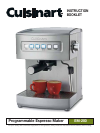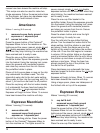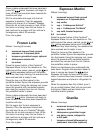
4
CONTENTS
Important Safeguards................... 2
Unpacking Instructions ................. 3
The Quest for the
Perfect Cup of Espresso ................ 4
Features and Benefits, Diagram........... 5
Preparing Your Espresso Machine
Before Use . . . . . . . . . . . . . . . . . . . . . . . . . . . 6
Programming Your Espresso Machine ..... 6
Guide to the Perfect Espresso ........... 7
Guide to Milk Texturing ................. 8
Using the Hot Water Function ............ 9
Cleaning and Maintenance .............. 9
Recipes ............................ 11
Warranty ............................ 19
THE QUEST FOR
THE PERFECT CUP
OF ESPRESSO
It is generally agreed that there are four basic
elements critical to the perfect cup:
Element 1: Water
When brewing espresso, make sure the water
flows through the filter at the correct pace.
The water flow can be adjusted by varying
the pressure with which the coffee is tamped
(pressed down) in the filter or by altering the
grind of the coffee. If the speed of the water
flow is too slow, the coffee will be over-
extracted and will be very dark and bitter, with
a spotted and uneven crema (froth) on the top.
If the speed of the water flow is too fast, the
coffee will be under-extracted and the supreme
flavor will not develop. The coffee will be
diluted and there will be an inadequate amount
of crema on the top.
Element 2: Coffee
While the bulk of the liquid is water, all of the
flavor should be from the coffee. To achieve the
same great quality of coffee you receive at a
café, you need to use the same quality beans.
If you choose to grind your own beans, buy the
beans fresh and whole, only about a two-week
supply at a time for maximum freshness. Once
the coffee bean is broken, its flavor degrades
very quickly. If it is not practical to buy smaller
supplies, we recommend you separate larger
amounts of beans and store them in airtight
containers in a cool, dry area. They should not
be kept for longer than 1 month as flavor will
diminish. Do not refrigerate or freeze coffee
beans.
Element 3: Grind
The grind of the coffee is critical for proper
flavor extraction. If using a pre-ground coffee,
be sure to purchase an espresso grind that is
specifically for espresso/cappuccino machines.
If the grind is too fine, over extraction and
bitterness will occur with a spotted and uneven
crema on the top. If the grind is too coarse, the
water will pass through too rapidly and
there will be an inadequate amount of
crema on the top of the espresso.
Element 4: Tamping the Coffee Grounds
If you choose to use ground espresso instead
of pods, tamping the coffee is a very important
part of the coffee making process. Use the
scoop supplied to fill the filter basket, then using
the tamping tool (flat end of the measuring
scoop), tamp (press down) down the grounds
with moderate pressure. Add more coffee and
tamp again if necessary to bring coffee to level.
Do not overfill the filter basket. The ground
coffee should be tamped with moderate
pressure. If the coffee is not tamped securely,
there is a chance that the water will flow through
the coffee too rapidly and the coffee will be
under-extracted. Note: If the coffee is tamped
too firmly, the water will flow through the
coffee too slowly and the coffee will be
over-extracted and may overflow through the
portafilter.


















